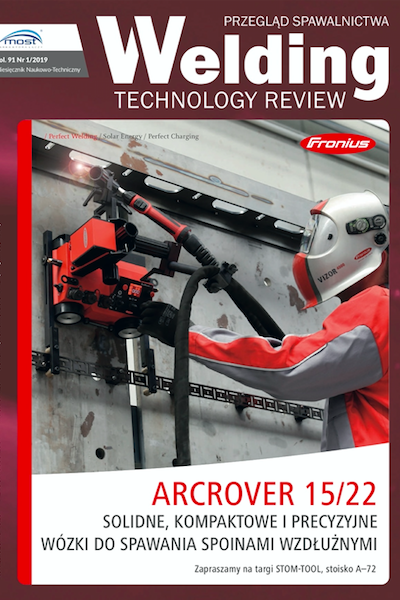Evaluation of welding properties of construction materials using the SEP 1390 tests
Main Article Content
Abstract
Issues connected with the evaluation of weldability of thick-walled materials used to manufacture welded steel structures were brought forward in the article. Evaluation of weldability determined by analytical methods and verified in a process test according to the guidelines of SEP 1390 was presented. This test is recommended forthe research of thick-walled construction materials, in particular those working under dynamic load. Hardness and metallographic tests were also conducted to assess plastic properties of the materials, very important from the point of view of weldability.The purpose of the topic taken on was the assessment of usefulness of different systems of evaluation of weldability of thick-walled construction materials intended to beused in welded structures.
Downloads
Article Details
Creative Commons CC BY 4.0 https://creativecommons.org/licenses/by/4.0/
Welding Technology Review (WTR) articles are published open access under a CC BY licence (Creative Commons Attribution 4.0 International licence). The CC BY licence is the most open licence available and considered the industry 'gold standard' for open access; it is also preferred by many funders. This licence allows readers to copy and redistribute the material in any medium or format, and to alter, transform, or build upon the material, including for commercial use, providing the original author is credited.
References
Poradnik inżyniera Spawalnictwo tom II, Wydawnictwo Naukowo-Techniczne (2005), Warszawa.
S. Butnicki, Spawalność i kruchość stali, Wydawnictwo Naukowo-Techniczne (1979), Warszawa.
J. Brózda, Stale konstrukcyjne i ich spawalność, Instytut Spawalnictwa (2009), Gliwice.
E. Tasak, Spawalność stali, Fotobit (2002), Kraków.
M. Myśliwiec, Cieplno-mechaniczne podstawy spawalnictwa, Wydawnictwo Naukowo-Techniczne (1972), Warszawa.
J. Węgrzyn, Fizyka i metalurgia spawania, Politechnika Śląska (1990), Gliwice.
J. Mikuła, Analityczne metody oceny spawalności stali, Zeszyty Naukowe Politechniki Krakowskiej, seria Mechanika (2001), Nr 85, Kraków.
Wytyczne ABV SEP 1390:1996.
R. Pakos, Technologiczna próba spawalności według ABV-SEP 1390,
Przegląd Spawalnictwa (2013), vol. 85(4), 14-17.
PN-EN 10025-2:2008 Wyroby walcowane na gorąco ze stali konstrukcyjnych Część 2: Warunki techniczne dostawy stali konstrukcyjnych niestopowych.
Świadectwo odbioru wytwórcy 3,1; blacha t40; S355J2+N.
Atest wytwórcy materiałów spawalniczych, elektroda OK FEMAX 33.80.
PN-EN ISO 9015-1:2011 Badania niszczące złączy spawanych metali Badanie twardości Część 1: Badanie twardości złączy spawanych łukowo.
PN-EN ISO 15614-1:2008 Specyfikacja i kwalifikowanie technologii spawania metali Badanie technologii spawania Część 1: Spawanie łukowe i gazowe stali oraz spawanie łukowe niklu i stopów niklu.
PN-EN ISO 17639:2013-12 Badania niszczące spawanych złączy metali Badania makroskopowe i mikroskopowe złączy spawanych.
R. Krawczyk, An analysis of the quality of the thick-walled S355J2+n steel joint welded by the MAG method, Archives of Metallurgy and Materials, (2017), vol. 62(2), 833-839.
R. Krawczyk, J. Kozłowski, Analiza wpływu zmian geometrii napoiny na przebieg próby SEP 1390, Biuletyn Instytutu Spawalnictwa w Gliwicach, (2016), vol. 60(4), 72-76.
J. Kozłowski, Próba Kommerella, a wytyczne SEP 1390:1996, Welding Technolgy Review (2018), vol. 90(5), 86-89.
K. Wojsyk, R. Krawczyk, D. Wierzchowski, Spawalnicze naprężenia i odkształcenia w konwencjonalnych ścianach szczelnych oraz ekranach nowej generacji, Welding Technolgy Review (2018), vol. 90(4), 20-23.
